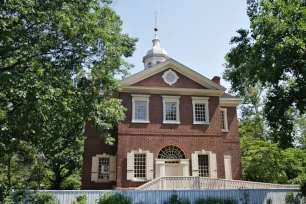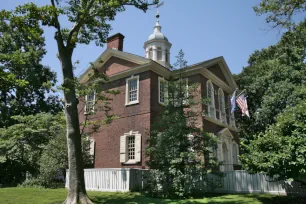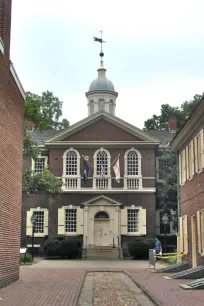Philadelphia’s Carpenters’ Hall – a Georgian structure built in 1770 – hosted the First Continental Congress in 1774.
A Rich History
The beautiful Georgian structure long known as Carpenters’ Hall holds an important place in the history of the United States and its early formation. Situated near the more-often-visited Independence Hall, one can argue that this historic site is nearly of equal importance to its popular neighbor.


The building is named for the Carpenters’ Company of the City and County of Philadelphia, the country’s oldest trade guild – established in 1724, which still owns and operates the site along with the National Park Service. The guild built the hall in 1770 based on designs by architect Robert Smith. The Company met annually in the hall and also allowed others to meet there.
In addition, the Library Company of Philadelphia, formed thirty years earlier by Ben Franklin and his cohorts, occupied the second floor of the building. Technically, this would become the first Library of Congress as use of the library was offered to the members of the First Continental Congress, held there in September 1774.
During the First Continental Congress, delegates made a list of the grievances of the Colonies against the King, and recommended that a Second Congress meet in May 1775 if issues were not solved. During the next year, numerous meetings took place there to discuss independence, including secret meetings with the French.
After war broke out, Carpenters’ Hall was used as an infirmary and, from Sept. 1777 to June 1778, was occupied by the British. After the war, it continued to be a meeting place for many local societies, including Franklin’s American Philosophical Society, which rented the first floor.
As the years passed, Carpenters’ Hall was home to the First and Second Bank of the United States, the Musical Fund Society, and the Franklin Institute, which is now a popular science center with its own large location. Numerous celebrations have also been held at Carpenter’s Hall, and it has often times been toured by visiting dignitaries who recognize it as an important part of early American history.

About the Building
Designed in the Georgian style that was so popular during the Colonial period, Carpenters’ Hall is a two-story, 50-foot-square building with 10 foot cutouts. It is said to be one of the most accurate historic buildings in the country, despite the lack of power tools and other devices that make measuring and building much easier today. The exterior brick walls are 13 inches thick and bore the weight of the building as there were no supports. The “rubble foundation” was made of stone, joined together by mortar. Since its construction, however, the building has been rescued by modern technology, which includes steel rods and trusses that have saved the building from crumbling.
Inside, visitors can view some historic furnishings, particularly numerous chairs that were made by well-known local chair makers. These Windsor-style chairs became known as “Philadelphia Chairs” and were somehow spared from becoming firewood during the long, cold nights of the American Revolution.

